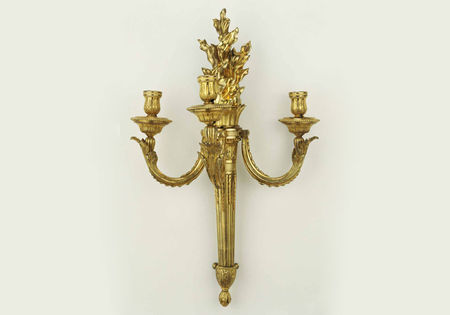"Made for Manufacture: Drawings for Sculpture and the Decorative Arts" @ the J. Paul Getty Museum
Stefano della Bella (Italian, 1610-1664), Design for an Ewer, about 1629. Pen and ink and blue wash, 35.9 X 25.7 cm. 2003.7 The J. Paul Getty Museum, Los Angeles.
LOS ANGELES, CA.- Many of the greatest artists from the 15th through the 18th centuries designed three-dimensional objects, and while the resulting pieces are celebrated, the drawings which preceded them are stunning works of art in their own right. Made for Manufacture: Drawings for Sculpture and the Decorative Arts, on view March 31 through July 5, 2008 at the J. Paul Getty Museum at the Getty Center, showcases detailed drawings from the Getty’s collection, whose designs guided craftsmen as they translated twodimensional ideas into three-dimensional objects.
Although it is commonly assumed that artists made drawings principally to plan paintings and frescoes, many, if not most of them, made drawings for the decorative arts as well. For example, the German master Albrecht Dürer and his pupil Sebald Beham designed stained glass and jewelry. Italian painters such as Taddeo Zuccaro made studies for majolica. Others produced designs for expensive tapestries and elaborate glass table ornaments. This exhibition showcases artists' ingenuity and demonstrates the key role drawing played in the creation of objects. It also highlights the collaborative relationship between artists and craftsmen. Made for Manufacture: Drawings for Sculpture and the Decorative Arts more includes designs to be executed in media such as metal, wood, glass, ceramics, and stone. Spanning the 1400s through the 1700s, the exhibition includes drawings from the Italian, German, French, Spanish, Netherlandish, and Flemish schools.
Not all the designs in the exhibition found their way into production. For instance, although elaborate glass table ornaments were common at the Medici court in Florence, it is unlikely the ingenious ewer designed by Stefano della Bella ever graced a table. A note by the artist hints at the design’s complexity: “The two tubes to fill the glass are marked A and B. They show that white wine should be poured into one tube and red wine into the other, so that the red will fill the eagles and snakes, and the other will fill the rest with white wine.” In the drawing, delicate blue wash evokes the presence of liquid inside a transparent shell.
Several of the drawings, however, do closely correspond to objects that have survived, including a drawing of a 1775 wall light attributed to Jean-Louis Prieur that the Getty Museum has in its collection. The actual wall light is mounted next to the drawing, showing that its original design changed very little in execution. Other surviving objects are pictured next to their designs.
Made for Manufacture: Drawings for Sculpture and the Decorative Arts will be on view in the West Pavilion of the J. Paul Getty Museum at the Getty Center, March 31 through July 5, 2008 and is curated by Stephanie Schrader, associate curator of drawings at the Getty Museum.
Unknown and Attributed to Jean-Louis Prieur (French, active 1765-1785), Wall Light, about 1775. Gilt bronze, Object: H: 68.6 X W: 33.7 X D: 26.7 74.DF.3.1 The J. Paul Getty Museum, Los Angeles

/https%3A%2F%2Fprofilepics.canalblog.com%2Fprofilepics%2F1%2F0%2F100183.jpg)




/http%3A%2F%2Fstorage.canalblog.com%2F74%2F16%2F119589%2F66401923_p.jpg)
/http%3A%2F%2Fstorage.canalblog.com%2F30%2F66%2F119589%2F66072338_p.jpg)
/http%3A%2F%2Fstorage.canalblog.com%2F10%2F09%2F119589%2F65502913_p.jpg)
/http%3A%2F%2Fstorage.canalblog.com%2F89%2F70%2F119589%2F63824397_p.jpg)